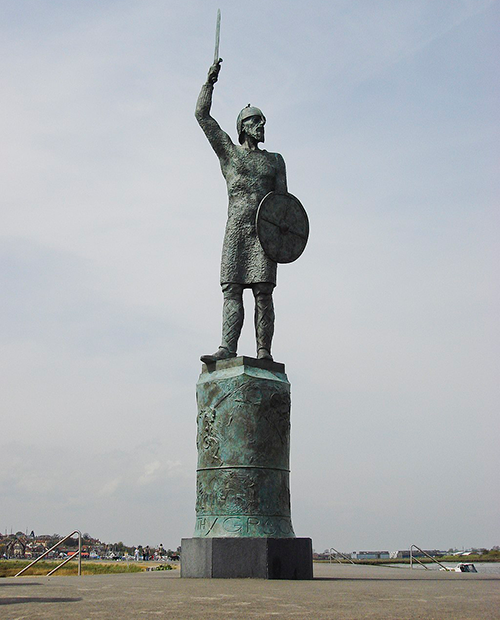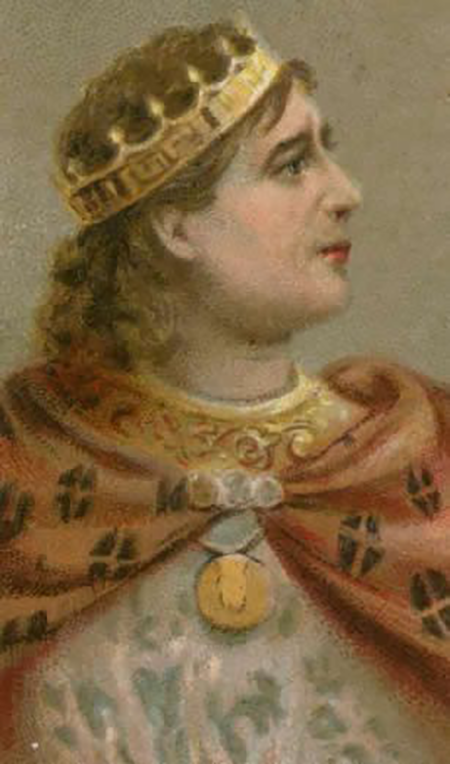



King Aethelred II The Unready
Quick Stats




Born: c. 968 AD
The Troubled Reign of King Æthelred the Unready: A Legacy of Turmoil and Resilience
King Æthelred II, often called "Æthelred the Unready," ruled England during one of its most turbulent periods (978–1016 AD). The nickname "Unready" derives from the Old English term "unræd," meaning "poorly advised" or "lacking counsel," rather than suggesting personal indecisiveness. His reign was marred by relentless Viking invasions, internal dissent, and controversial decisions, yet it was also a time of resilience and significant administrative evolution.
Viking Threats and the Danegeld
One of the defining challenges of Æthelred’s reign was the resurgence of Viking raids. The Scandinavian threat, which had largely subsided during his father’s reign, returned with devastating force in the late 10th century. Starting in 980 AD, Viking forces launched frequent raids on England’s coasts, plundering towns and monasteries. These invasions exposed the kingdom's vulnerability and tested the effectiveness of its defenses.
One of the defining challenges of Æthelred’s reign was the resurgence of Viking raids. The Scandinavian threat, which had largely subsided during his father’s reign, returned with devastating force in the late 10th century. Starting in 980 AD, Viking forces launched frequent raids on England’s coasts, plundering towns and monasteries. These invasions exposed the kingdom's vulnerability and tested the effectiveness of its defenses.
To counter these incursions, Æthelred adopted a policy of paying the Danegeld, a form of tribute intended to buy peace. This strategy, while occasionally effective, was immensely costly and often seen as a sign of weakness. Between 991 and 1012, Æthelred’s government paid vast sums of silver to the Vikings, depleting the kingdom’s resources and encouraging further attacks.
Notable events during this period include
The Battle of Maldon (991 AD)
: English forces, led by Byrhtnoth, were defeated by Viking raiders in a bloody engagement. This battle highlighted the inadequacies of England's military response and became immortalized in an Old English poem.
Sweyn’s sudden death in 1014 provided Æthelred with an opportunity to reclaim the throne. He returned to England and briefly regained power, but his authority remained weak. The continued Viking presence, coupled with internal dissent, made it nearly impossible to govern effectively.
The Fall of Æthelred’s Reign
By the early 11th century, the Viking threat had reached its peak. Sweyn Forkbeard launched a full-scale invasion of England, culminating in his conquest of the kingdom in 1013. Forced to flee, Æthelred sought refuge in Normandy with his wife and children. This period of exile marked a low point in Æthelred’s reign, as the once-powerful kingdom of England seemed on the brink of collapse.
By the early 11th century, the Viking threat had reached its peak. Sweyn Forkbeard launched a full-scale invasion of England, culminating in his conquest of the kingdom in 1013. Forced to flee, Æthelred sought refuge in Normandy with his wife and children. This period of exile marked a low point in Æthelred’s reign, as the once-powerful kingdom of England seemed on the brink of collapse.
Emma’s influence extended beyond her role as queen consort. Her Norman heritage played a key role in fostering connections between England and the Continent, laying the groundwork for the Norman Conquest later in the century. The legacy of her marriage to Æthelred would endure long after his death, shaping the future of the English monarchy.
Political and Military Challenges
The Viking invasions were not the only source of turmoil during Æthelred’s reign. Internal divisions among the English nobility weakened the kingdom’s ability to mount a unified defense. Key figures in Æthelred’s court often acted out of self-interest, undermining his authority and complicating efforts to resist the Vikings.
The Viking invasions were not the only source of turmoil during Æthelred’s reign. Internal divisions among the English nobility weakened the kingdom’s ability to mount a unified defense. Key figures in Æthelred’s court often acted out of self-interest, undermining his authority and complicating efforts to resist the Vikings.
Æthelstan Ætheling
Children with Ælfgifu of York:
Emma or Normandy
Wives: Aelfgifu of York
Father: King Edgar The Peaceful
Mother: Queen Aelfthryth
Died: 23 April 1016 AD
Edmund Ironside
Ecgberht Ætheling
Eadred Ætheling
Eadwig Ætheling
Children with Emma of Normandy:
Edward the Confessor
Alfred Ætheling
Godgifu (Goda)
Predecessor: King Edward the Martyr
Successor: King Edmund Ironside
Early Life and Ascension to the Throne
Born around 968 AD, Æthelred was the youngest son of King Edgar the Peaceful and Queen Ælfthryth. His early years were overshadowed by political turmoil. In 978 AD, at just 10 years old, he became king following the assassination of his half-brother, Edward the Martyr. The circumstances of Edward’s murder remain shrouded in mystery, but suspicions of Queen Ælfthryth’s involvement created lasting enmity among Edward’s supporters.
Born around 968 AD, Æthelred was the youngest son of King Edgar the Peaceful and Queen Ælfthryth. His early years were overshadowed by political turmoil. In 978 AD, at just 10 years old, he became king following the assassination of his half-brother, Edward the Martyr. The circumstances of Edward’s murder remain shrouded in mystery, but suspicions of Queen Ælfthryth’s involvement created lasting enmity among Edward’s supporters.
Æthelred's youth and inexperience left him vulnerable to manipulation by powerful noble factions. This instability at the start of his reign would have long-lasting repercussions, particularly as Viking incursions into England escalated. His accession marked the beginning of a reign fraught with challenges, as the young king struggled to assert his authority in a politically fragmented kingdom.
The St. Brice’s Day Massacre (1002 AD)
: Æthelred ordered the killing of all Danes living in England. While intended to demonstrate strength, this act had the opposite effect, enraging King Sweyn Forkbeard of Denmark and provoking a series of retaliatory invasions.
These episodes underscored the precariousness of Æthelred's position, as the kingdom faced external aggression and internal discord simultaneously.

Additionally, Æthelred’s military campaigns were often poorly coordinated and lacked consistent success. The king’s reliance on mercenaries and local militias, coupled with instances of betrayal and desertion, further hampered England’s ability to repel Viking forces. The constant need to defend against raids strained both the kingdom’s financial resources and its social cohesion.
Despite these challenges, Æthelred introduced reforms aimed at improving governance and military readiness. He issued numerous legal codes to address societal issues and sought to centralize royal authority. While these efforts showed promise, they were often overshadowed by the immediate crises posed by Viking incursions.
Marriage Alliances and Family
Æthelred’s personal life played a significant role in his reign. His first marriage to Ælfgifu of York produced several children, including Æthelstan Ætheling and Edmund Ironside, both of whom played prominent roles in England’s defense against the Vikings. Æthelstan, a promising heir, died young, leaving Edmund to take up the mantle of leadership in the kingdom’s darkest hour.
Æthelred’s personal life played a significant role in his reign. His first marriage to Ælfgifu of York produced several children, including Æthelstan Ætheling and Edmund Ironside, both of whom played prominent roles in England’s defense against the Vikings. Æthelstan, a promising heir, died young, leaving Edmund to take up the mantle of leadership in the kingdom’s darkest hour.
After Ælfgifu’s death, Æthelred married Emma of Normandy in 1002 AD. This union was intended to strengthen ties with Normandy and secure an ally against Viking incursions. Emma bore Æthelred three children: Edward the Confessor, Alfred Ætheling, and Godgifu (Goda). Despite this strategic alliance, Æthelred’s position remained precarious as Viking pressure continued to mount.
In 1016, Æthelred died amid a renewed Viking campaign led by Sweyn’s son, Cnut. His death marked the end of a troubled reign and paved the way for Cnut’s eventual domination of England. Despite his struggles, Æthelred’s efforts to resist Viking aggression and maintain the kingdom’s integrity demonstrated a resilience that would resonate in the years to come.
Legacy and Historical Interpretations
Æthelred the Unready’s reign has often been criticized for its failures to repel Viking invasions and maintain internal stability. However, modern historians have reevaluated his legacy, recognizing the immense challenges he faced and the administrative efforts he implemented
Æthelred the Unready’s reign has often been criticized for its failures to repel Viking invasions and maintain internal stability. However, modern historians have reevaluated his legacy, recognizing the immense challenges he faced and the administrative efforts he implemented
Legal Reforms: Æthelred issued numerous legal codes aimed at strengthening royal authority and addressing societal issues. These laws reflected a commitment to justice and order, even amid the chaos of Viking invasions.
Administrative Innovations: Efforts to centralize governance and improve taxation systems laid the groundwork for later reforms. The creation of a more structured bureaucracy helped ensure the kingdom’s resilience in the face of adversity.
Diplomatic Alliances: Æthelred’s marriage to Emma of Normandy fostered connections with the Continent and shaped the future of English politics. This alliance demonstrated his willingness to seek innovative solutions to the kingdom’s challenges.
While his reign ended in turmoil, Æthelred’s legacy lived on through his children, particularly Edward the Confessor, who became one of England’s most revered monarchs. The lessons of his reign influenced subsequent rulers, highlighting the importance of adaptability and resilience in the face of external threats.
Conclusion
King Æthelred the Unready’s 38-year reign was one of the most challenging periods in English history. Despite his efforts to address the Viking threat and maintain stability, his reign was overshadowed by political strife and external invasions. Nevertheless, his resilience and administrative reforms left a lasting impact on the kingdom, providing a foundation for future monarchs to build upon. Æthelred’s story serves as a poignant reminder of the complexities and challenges of medieval kingship. His legacy, though often misunderstood, is a testament to the enduring spirit of England during one of its darkest eras.
King Æthelred the Unready’s 38-year reign was one of the most challenging periods in English history. Despite his efforts to address the Viking threat and maintain stability, his reign was overshadowed by political strife and external invasions. Nevertheless, his resilience and administrative reforms left a lasting impact on the kingdom, providing a foundation for future monarchs to build upon. Æthelred’s story serves as a poignant reminder of the complexities and challenges of medieval kingship. His legacy, though often misunderstood, is a testament to the enduring spirit of England during one of its darkest eras.
Statue of Byrhtnoth in Maldon Essex, English Leader in the Battle of Maldon



